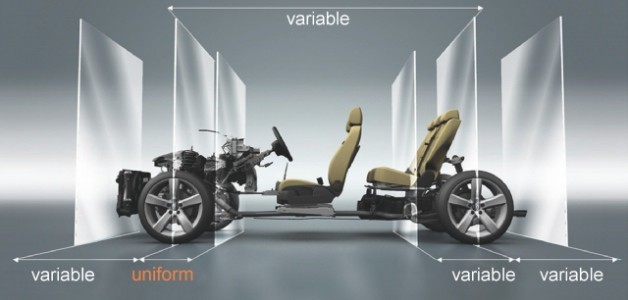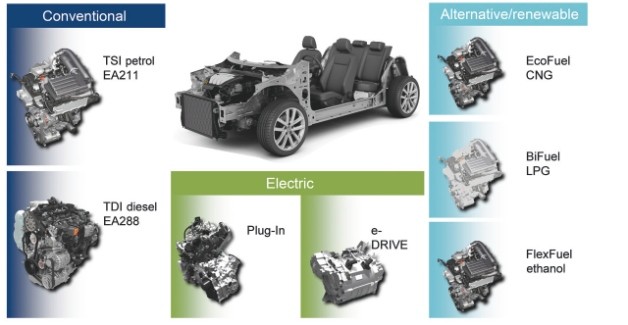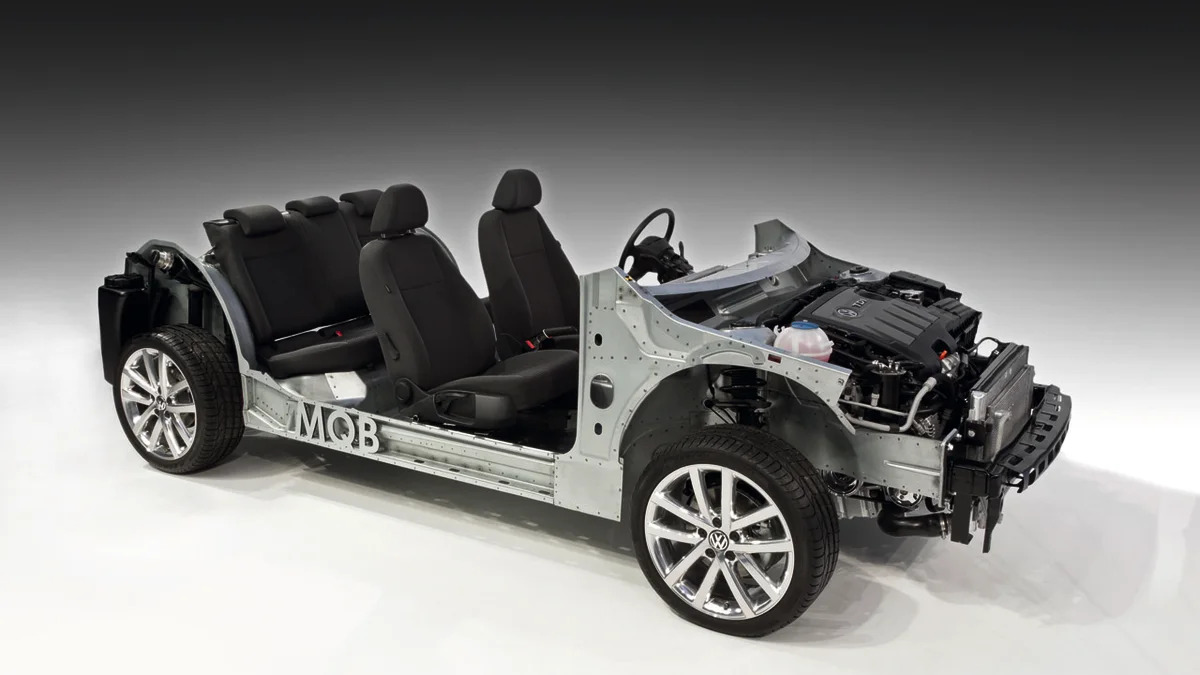Lighter, faster, stronger, better. That's what we can expect from the seventh-generation Volkswagen Golf, due to be unveiled at the 2012 Paris Motor Show before it hits dealerships across Europe this fall and eventually lands on U.S. shores as a 2013 model.The next GTI will be an order of magnitude better, bringing it back in line with the original hot hatch.
So what makes it special? A combination of new manufacturing processes, an all-new platform, a range of upgraded engines and what will go down as one of the greatest democratizations of active safety and in-car technology in automotive history.
What's more, the next GTI will be an order of magnitude better because of it, bringing it back in line with the original hot hatch while packed with even more standard features.
It all starts with Volkswagen's new Modular Transverse Matrix (MQB) platform, which is set to underpin every front-wheel-drive VW product from the Polo to the Passat, along with the 2013 Audi A3. To hear VW tell it, it will redefine the automaker's manufacturing processes while curing world hunger and eradicating leprosy.
Read on to find out what's got Volkswagen so excited.
The new platform is like a set of chassis Legos, allowing Volkswagen to swap out five of the six modular blocks to accommodate everything from longer wheelbases to alternative powertrains, battery packs and fuel tanks. The only component that's fixed is the space between the front axle and firewall, which is set 40mm further back than the current Golf and on paper should make this new model less nose heavy and more balanced.VW's turbocharged 2.0-liter will max-out at 280 hp.

More impressive is the overall weight reduction VW hopes to achieve through the use of high-strength steel, aluminum and a new patented manufacturing process that can weld the two together on the same line. Across the board, the 2013 Golf will be around 150 pounds lighter than the Mk6 (which is essentially a slightly modified Mk5) thanks to molten-molded, extra high-strength steel used throughout the chassis, along with reworked suspension components, lightened engines and auxiliary bits. VW officials tell us that it wants the next Golf to be the same weight as the Mk4 model from the 90s, and the proliferation of aluminum in the chassis and roof means the next GTI should be over 200 pounds lighter than the current model.
However, in the process of reducing overall weight, VW plans to stuff the new Golf with a range of standard and optional infotainment and safety features that used to be the exclusive purview of luxury models costing three-times as much.
We already revealed VW's new line of NVIDIA-powered modular infotainment systems, and along with that, the new Golf will be available with radar- and camera-based adaptive cruise control, parking assist, auto-dimming headlights, an electronic parking brake and a Mercedes-like fatigue detection system that will let the driver know when it's time for a nap and a cup of coffee.

Engines will span the spectrum from 1.4- to 2.0-liters, but in the U.S., don't expect the turbo'd 1.4 to arrive for a few more years. However, the new 1.8T is set to put out up to 180 horsepower and the turbocharged 2.0-liter – making use of Audi's Valvelift system – will max-out at 280 hp. But fear not, your front tires are safe. Sorta. The GTI variant is likely to be limited to around 230-240 hp, but torque will be up to nearly 260 pound-feet. And if that's not enough twist for you, VW is working on a new 2.0-liter turbo diesel that's set to output 190 hp and 280 lb-ft of torque, which means the GTD – the Euro-only diesel-flavored GTI – will be even more potent. Let's hope VW sees the light and ships it our way.
Finally, a reworked suspension and all-new electric steering rack that will be more direct and more efficient will work in concert with a new type of electronically-controlled mechanical limited-slip differential that nixes the much-maligned brake-based system on current GTIs. It's already been tested at the Nürburgring and VW claims it's 8.5 seconds quicker around Green Hell than its standard counterpart.Both the old and new models will be sharing dealership space. And that could be a problem.
So when do we get it? Well, the Golf is likely to arrive in the States in 2013, with the Mk7 GTI landing a year or so after that. We've been told the 2013 GTI will be a carryover of the Mk6 in the U.S., so both the old and new models will be sharing dealership space. And that could be a problem.
Because of the new manufacturing and material processes, parts costs will be cut by around 20 percent and manufacturing costs will be reduced by one-third, meaning the next Golf should be less expensive than the current model, while packing even more content, providing more power and even better handling. Sell that alongside the current GTI and people will ask, "Why upgrade?" We wouldn't either, but then again, we'd wait for the next GTI anyway, or maybe that oil-burning GTD...
The beginning of a new era: Volkswagen introduces the Modular Transverse Matrix (MQB)
MQB exploits synergies in key technologies across vehicle classes and brands
MQB makes luxury class technologies accessible to high-volume models
Wolfsburg, 01 February 2012 - This year, Volkswagen Group will be introducing the Modular Transverse Matrix – the German acronym is MQB – for the Volkswagen, Audi, ŠKODA and SEAT brands. The MQB strategy represents a turning point in the design and production of future automobiles with transverse-mounted engines. The Modular Transverse Matrix standardises many vehicle component parameters – across brands and vehicle classes. At the same time, it offers access to new technologies. The MQB extends from the A0 to the B segment. At the Volkswagen brand, for example, it covers the following models: Polo, Beetle, Golf, Scirocco, Jetta, Tiguan, Touran, Sharan, Passat and Volkswagen CC. In the future, all of these models could theoretically be produced on the same assembly line – despite their different wheelbases and track widths. It will be possible to produce MQB models of different brands together. The first new vehicles to be produced based on the MQB will be the successor to the Audi A3 and the next generation Golf.
One of the prominent characteristics of the Modular Transverse Matrix is the uniform mounting position of all engines. Two systems integrated in the MQB strategy which play a key role here are the modular petrol engine system (MOB) with the new EA211 engine series (40 kW / 60 PS to 110 kW / 150 PS) – this range includes the world's first four-cylinder engine with cylinder deactivation (ACT) – and the modular diesel engine system (MDB) with the also new EA288 engine series (66 kW / 90 PS to 140 kW / 190 PS). In one fell swoop, the new engine series will reduce the Group's engine and gearbox variants in the MQB system by approximately 90 per cent. Without any negative effects. On the contrary, in addition to standardising conventional internal combustion engines, the MQB also enables an identical mounting position for all current alternative drive concepts without limitations – from natural gas and hybrid versions to the pure electric drive. Volkswagen has already announced the launch of the latter within the MQB in 2013 in the new Golf Blue-e-Motion.
The MQB opens up new opportunities at Volkswagen Group, allowing it to produce high-volume and niche models at the highest quality and extremely competitive costs over the long term and worldwide – vehicles that are individually tailored to the requirements of very diverse markets such as Europe, China and America, as well as emerging markets such as India. In parallel, Volkswagen Group will significantly reduce vehicle weights with the launch of the first MQB model series and will introduce 20 innovations in the areas of safety and infotainment, which until now were reserved for higher vehicle segments.
They include the new multicollision brake; after an initial collision, it helps to reduce the intensity of secondary collisions by automatically initiated braking. Very recently, ADAC awarded this system the 'Yellow Angel' award for innovations. The multicollision brake will be standard equipment in the next generations of the Audi A3 and the Golf.
Within the Group, the MQB developed under the auspices of the Volkswagen brand is supplemented by the Modular Longitudinal System (MLB) from Audi, the Modular Standard System (MSB) with Porsche as the competence centre and finally the 'New Small Family' – the most compact vehicle model series with the Volkswagen up!, SEAT Mii and ŠKODA Citigo.
One indicator of the pioneering significance of the modular systems strategy and the innovative potential realised by these new vehicle and production architectures is that Volkswagen was selected as one of five finalists for the 'Innovation Award of the German Economy – The World's First Innovation Award®' for its Modular Transverse Matrix. This prestigious award for outstanding technical, scientific and intellectual achievements has been awarded annually since 1980 by the Economics Club of Rhein-Main and since 2011 in conjunction with the newspaper Frankfurter Allgemeine Zeitung. On 11 February, the prize winners will be announced at the Palais 'Thurn und Taxis' in Frankfurt, Germany, by Günther Oettinger, EU Commissar for Energy. The anticipation grows!
MQB exploits synergies in key technologies across vehicle classes and brands
MQB makes luxury class technologies accessible to high-volume models
Wolfsburg, 01 February 2012 - This year, Volkswagen Group will be introducing the Modular Transverse Matrix – the German acronym is MQB – for the Volkswagen, Audi, ŠKODA and SEAT brands. The MQB strategy represents a turning point in the design and production of future automobiles with transverse-mounted engines. The Modular Transverse Matrix standardises many vehicle component parameters – across brands and vehicle classes. At the same time, it offers access to new technologies. The MQB extends from the A0 to the B segment. At the Volkswagen brand, for example, it covers the following models: Polo, Beetle, Golf, Scirocco, Jetta, Tiguan, Touran, Sharan, Passat and Volkswagen CC. In the future, all of these models could theoretically be produced on the same assembly line – despite their different wheelbases and track widths. It will be possible to produce MQB models of different brands together. The first new vehicles to be produced based on the MQB will be the successor to the Audi A3 and the next generation Golf.
One of the prominent characteristics of the Modular Transverse Matrix is the uniform mounting position of all engines. Two systems integrated in the MQB strategy which play a key role here are the modular petrol engine system (MOB) with the new EA211 engine series (40 kW / 60 PS to 110 kW / 150 PS) – this range includes the world's first four-cylinder engine with cylinder deactivation (ACT) – and the modular diesel engine system (MDB) with the also new EA288 engine series (66 kW / 90 PS to 140 kW / 190 PS). In one fell swoop, the new engine series will reduce the Group's engine and gearbox variants in the MQB system by approximately 90 per cent. Without any negative effects. On the contrary, in addition to standardising conventional internal combustion engines, the MQB also enables an identical mounting position for all current alternative drive concepts without limitations – from natural gas and hybrid versions to the pure electric drive. Volkswagen has already announced the launch of the latter within the MQB in 2013 in the new Golf Blue-e-Motion.
The MQB opens up new opportunities at Volkswagen Group, allowing it to produce high-volume and niche models at the highest quality and extremely competitive costs over the long term and worldwide – vehicles that are individually tailored to the requirements of very diverse markets such as Europe, China and America, as well as emerging markets such as India. In parallel, Volkswagen Group will significantly reduce vehicle weights with the launch of the first MQB model series and will introduce 20 innovations in the areas of safety and infotainment, which until now were reserved for higher vehicle segments.
They include the new multicollision brake; after an initial collision, it helps to reduce the intensity of secondary collisions by automatically initiated braking. Very recently, ADAC awarded this system the 'Yellow Angel' award for innovations. The multicollision brake will be standard equipment in the next generations of the Audi A3 and the Golf.
Within the Group, the MQB developed under the auspices of the Volkswagen brand is supplemented by the Modular Longitudinal System (MLB) from Audi, the Modular Standard System (MSB) with Porsche as the competence centre and finally the 'New Small Family' – the most compact vehicle model series with the Volkswagen up!, SEAT Mii and ŠKODA Citigo.
One indicator of the pioneering significance of the modular systems strategy and the innovative potential realised by these new vehicle and production architectures is that Volkswagen was selected as one of five finalists for the 'Innovation Award of the German Economy – The World's First Innovation Award®' for its Modular Transverse Matrix. This prestigious award for outstanding technical, scientific and intellectual achievements has been awarded annually since 1980 by the Economics Club of Rhein-Main and since 2011 in conjunction with the newspaper Frankfurter Allgemeine Zeitung. On 11 February, the prize winners will be announced at the Palais 'Thurn und Taxis' in Frankfurt, Germany, by Günther Oettinger, EU Commissar for Energy. The anticipation grows!






Sign in to post
Please sign in to leave a comment.
Continue